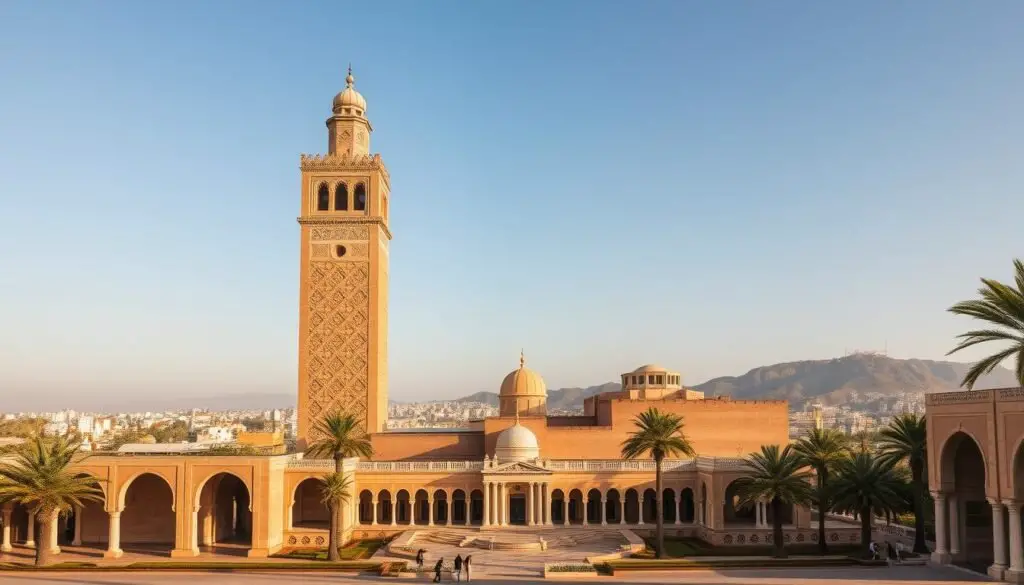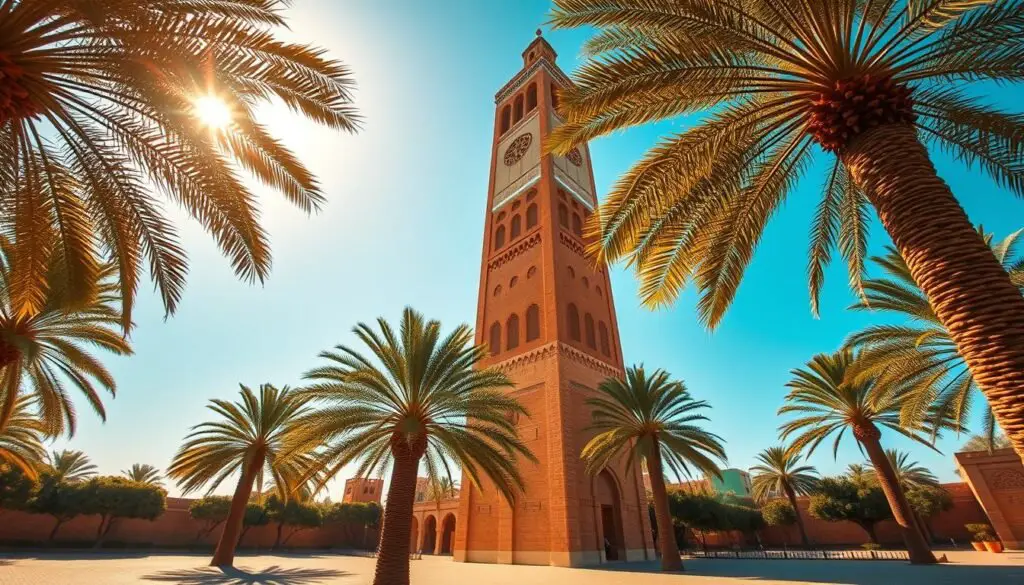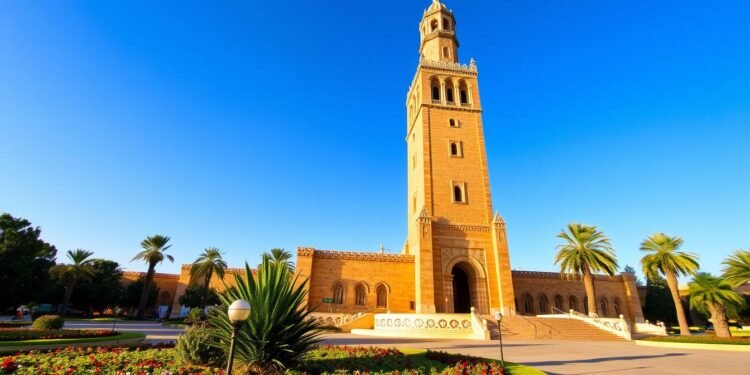Have you ever wondered what makes a 12th-century structure stand out as a symbol of history and architecture? The answer lies in the heart of Morocco, where the Hassan Tower stands as a testament to the Almohad legacy. This iconic monument, located in Rabat, is more than just a tower—it’s a gateway to understanding Morocco’s rich past.
Built in the late 12th century, the tower was intended to be the largest minaret in the world. Though unfinished, its grandeur remains unmatched. Standing at 44 meters, it showcases intricate designs and patterns that reflect the Almohad architectural style. Its strategic location along the Bou Regreg River adds to its allure, making it a must-visit for travelers.
Adjacent to the Mausoleum of Mohammed V, the site forms part of a historical complex that has been recognized as a UNESCO World Heritage Site since 2012. This guide will take you through the fascinating history and architectural marvels of this iconic landmark, offering insights into its significance in Moroccan heritage.
Key Takeaways
- The Hassan Tower is a 12th-century monument located in Rabat, Morocco.
- It was intended to be the largest minaret in the world but remains unfinished.
- The tower is part of a UNESCO World Heritage Site, recognized in 2012.
- Its architecture reflects the Almohad style, with intricate designs and patterns.
- Located near the Bou Regreg River, it forms part of a historical complex with the Mausoleum of Mohammed V.
Hassan Tower Rabat: A Glimpse into Its Grand Past
Few structures capture the ambition of a medieval empire like this unfinished masterpiece. Commissioned in 1191 by Yaqub al-Mansur, the Almohad ruler, it was meant to crown his new capital, Ribat al-Fath. The project symbolized both religious devotion and imperial power.

The Vision of Yaqub al-Mansur
After his victory at the Battle of Alarcos in 1195, Yaqub al-Mansur expanded the mosque complex’s scale. Plans included the world’s largest minaret, soaring 80 meters high. The design mirrored the Koutoubia and Giralda, showcasing Almohad architectural pride.
Workers erected 348 columns and laid sandstone foundations. The construction reflected cutting-edge 12th-century engineering, like interior ramps for horses. But fate had other plans.
Why Construction Was Abandoned
In 1199, Yaqub al-Mansur died unexpectedly. Without his leadership, resources dwindled, halting the project. The Lisbon earthquake of 1755 further damaged the columns and walls.
Centuries later, French and Moroccan teams restored the site. Today, it stands as a testament to what could have been—and the enduring legacy of a ruler’s dream.
The Architectural Marvel of Hassan Tower
Step into a world where medieval engineering meets artistic grandeur. This iconic structure stands as a testament to the Almohad dynasty’s vision and skill. Its design reflects a blend of functionality and beauty, making it a must-see for history and architecture enthusiasts.

Inspired by the Koutoubia and Giralda
The design of this monument draws inspiration from two iconic landmarks: the Koutoubia Mosque in Marrakech and the Giralda in Seville. These structures share similar architecture, showcasing the Almohad style’s geometric precision and elegance. The influence is evident in the intricate patterns and overall layout.
Unique Features: Ramps and Sandstone Design
One of the most innovative aspects of this structure is its ramp system. Unlike traditional stairs, these ramps were designed for muezzins to ascend on horseback. The use of sandstone adds durability and a warm, reddish hue, while the sebka patterns highlight the Almohad’s artistic flair.
The Unfinished Mosque: Columns and Layout
The mosque’s footprint spans 183 meters by 139 meters, with a hypostyle layout featuring 21 aisles. Originally, 348 cylindrical columns were planned to support the vast interior. Three courtyards were designed to bring natural light into the space, creating a harmonious balance between form and function.
Cultural Significance and UNESCO Recognition
How did a medieval project evolve into a UNESCO-recognized treasure? This iconic site stands as a testament to Morocco’s rich history and architectural brilliance. From its humble beginnings as an unfinished structure, it has grown into a symbol of national pride and cultural identity.
From Ruins to Restoration
For centuries, this site lay in ruins, a reminder of an ambitious vision left incomplete. In the 1960s, restoration efforts began, transforming it into a national treasure. The integration with the Mausoleum of Mohammed V in 1971 created a cultural complex that highlights Morocco’s historical continuity.
A Symbol of Rabat’s Heritage
In 2012, UNESCO recognized this city as part of its “Shared Heritage” initiative. The site showcases the Almohad architectural influence, blending history with modern significance. Today, it serves as a popular filming location and a venue for cultural events, further cementing its role in Moroccan identity.
Visiting Hassan Tower: What to See Nearby
Discover the treasures that surround this iconic landmark and enrich your visit to Morocco. From royal tombs to ancient ruins, the area offers a wealth of cultural and historical experiences.
The Mausoleum of Mohammed V
Adjacent to the tower, the Mausoleum of Mohammed V is a masterpiece of Moroccan craftsmanship. Designed by Vietnamese architect Cong Vo Toan, it features stunning white marble and intricate tilework. Inside, you’ll find the royal tombs of King Mohammed V and his sons, King Hassan II and Prince Abdallah.
Don’t miss the ceremonial changing of the guard, performed by the Royal Guard in their vibrant red uniforms. This complex is a must-visit for anyone interested in Morocco’s royal heritage.
Exploring the Imperial Cities of Morocco
Extend your trip by visiting the Imperial Cities of Meknes and Fez. These historic places offer a glimpse into Morocco’s rich past. Meknes is known for its grand gates and bustling medina, while Fez boasts the world’s oldest university and a labyrinth of narrow streets.
For a seamless experience, consider a guide to help you navigate these cities. A day trip to these destinations is a perfect addition to your itinerary.
Nearby, the Kasbah of the Udayas and Chellah Necropolis are also worth exploring. The Kasbah offers picturesque views and charming blue-and-white houses, while Chellah combines Roman ruins with serene gardens.
Practical tips: Visit at sunset for the best photo opportunities. Entry to the mausoleum mohammed and tower is free, and guided tours are available for a deeper understanding of the site’s history.
Conclusion
A journey through Morocco’s history is incomplete without exploring its iconic landmarks. This site stands as a top destination, blending historical depth, architectural brilliance, and cultural significance. Its UNESCO recognition highlights its global importance, making it a must-visit place in Rabat.
Pair your visit with the nearby Mausoleum of Mohammed V and other Rabat highlights for a richer experience. These sites work together to tell the story of Morocco’s past and present. For those with more time, extending your trip to the Imperial Cities offers a deeper dive into the country’s heritage.
Plan your day with a trusted guide to uncover every detail of this historical part of Morocco. Start your adventure today and create memories that will last a lifetime.
FAQ
What is the historical significance of this iconic monument?
The site was commissioned by Yaqub al-Mansur in the 12th century as part of a grand project to build the world’s largest mosque. Though unfinished, it remains a symbol of Morocco’s rich history and architectural ambition.
Why was the construction of the mosque abandoned?
Construction halted after the death of Yaqub al-Mansur in 1199. The project was never resumed, leaving the structure incomplete but still a testament to the vision of its time.
What makes the architecture of this site unique?
The design draws inspiration from the Koutoubia Mosque and the Giralda of Seville. Its sandstone construction, ramps, and rows of unfinished columns showcase a blend of innovation and tradition.
What can visitors see at the site today?
Visitors can explore the towering minaret, the remains of the mosque’s columns, and the nearby Mausoleum of Mohammed V. The area offers a glimpse into Morocco’s imperial past and cultural heritage.
Is the site recognized by UNESCO?
Yes, it is part of Rabat’s UNESCO World Heritage Site, celebrated for its historical and architectural importance.
What are some nearby attractions to visit?
The Mausoleum of Mohammed V is a must-see, along with other landmarks in Rabat. The city is also a gateway to Morocco’s imperial cities, such as Fez and Marrakech.
How tall is the minaret, and what was its purpose?
The minaret stands at 44 meters, though it was originally intended to reach 80 meters. It was designed as a prayer tower and a symbol of the mosque’s grandeur.




